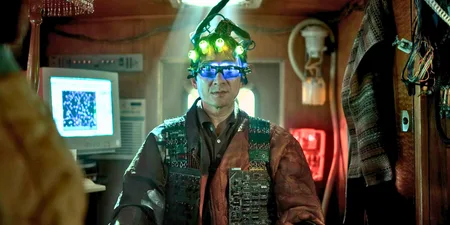The greatest super-hero film of all time?
Spider-Man: Into The Spider-Verse is one of the most critically acclaimed superhero films ever, and it has just been added to Netflix in the UK. So we are reposting our interview with the film’s co-directors Bob Persichetti, Rodney Rothman and Peter Ramsey. Enjoy!
“Anyone can wear the mask. That was our mantra,” says Into The Spider-Verse’s co-director Bob Persichetti, and he is right.
Superman is Clark Kent just without the glasses. Bruce Wayne’s distinctive chin is clearly visible when he’s wearing the cowl. But Spider-Man could be anyone under the mask.
Any age, any race, any gender. Any kid can imagine it is them under the familiar webbing and big eyes.
Although a leaked Sony Pictures memo showed that their licensing agreement meant Spidey had to be white, male and heterosexual, in his latest film, Spider-Man breaks convention. In it, he is a half Africa-American, half-Lantinx teenager. And a Caucasian teenage girl. And a dead-beat dad, and 1940s noir anti-hero. And also a talking pig.
Into The Spider-Verse focuses on Miles Morales, the multiracial alternate universe Spider-Man introduced into the comics in 2008. The film starts out with Miles getting his powers from a spider’s bite, just like Peter Parker, but quickly he finds himself having to team up with multiple Spider-Men and Women from different realities.
All of these different interpretations of the character are based on comic book storylines. There’s Spider-Gwen, from a world where Peter Parker’s college sweetheart gets bitten by a radioactive spider instead of him. There’s a forty-something version of Peter, past his prime and now sporting a beer gut.
There’s also Peni Parker, an anime-inspired character with a giant robot spider mech, and Spider-Ham, a funny-animal version, and Spider-Man Noir, voiced by Nicolas Cage.
“Part of Miles’s story is that he becomes Spider-Man in a world where there is already a Spider-Man,” says another of the film’s three co-directors, Rodney Rothman. “That opened the door for us to look at what Spider-Man means to us.
“He’s a ubiquitous character these days in a lot of different media. So it only makes sense to acknowledge that and have fun with that.”
Spidey is more than just a comic book character now – for proof, you just have to look at how the scene from Avengers: Infinity War where Tom Holland turns into dust became one of Twitter‘s biggest memes.
And the idea of the character being adapted and remixed to become more than just what’s on the page or screen is something Into The Spider-Verse tackles head on.
“We live in a culture that for the last 30 years has been all about reinterpreting and remixing everything,” Rothman says. “It has reached just about every part of culture. So I think the idea of the multiverse is something we’ve all been living with for a while now.”
That approach extends to not just the film’s story, but also to its design. The animation is unique – three-dimensional and computer-generated, but with character design that resembles a tradition 2D cartoon, along with strange, jerky movement that feel almost like stop motion. The art style changes on a whim, with comic-book style panels and sound effects also littering the screen.
The filmmakers cite everything from fine art to anime as influences, but one of the most important was Miles and Peter’s home of New York.
Something that made Spider-Man and his alumni of Marvel Comics heroes stand out when they were created in the 1960s was that unlike the Superman of Metropolis or the Batman of Gotham, they were set in a recognisable, real world. Peter Parker was a regular kid from Queens.
Capturing this was vital for the filmmakers and they visited the city very early in production, taking hundreds of photos. “If I was a 13-year-old kid in Brooklyn walking down the street, what I would I see?” says Peter Ramsey, the film’s third and final director. “What would have an impact on me? What are touchstones? The details that are going to make this movie really feel like it is taking place in a real world.”
“We really tried to imbue it with the texture, and tone, and life, of the city,” adds Persichetti.
Nowhere is this better portrayed than by the Air Jordan 1 trainers that Miles wears in the film, which caused a sensation online when the first trailer was released.
One item of clothing told you so much about Miles’ character. “We don’t have any endorsement or sponsorship,” Rothman points out. “But it’s amazing how that simple choice helped a lot of people immediately identify with Miles.”
“New York being the birthplace of not just Spider-Man, but also Hip-Hop – so much of current culture has flowed through the prism of [the city],” adds Ramsey. “We just thought it was a great place to bring all these things together, that had their genesis in New York City.”
Yet what also made Spider-Man such a revolutionary character was his relatability.
Superheroes had previously provided power fantasies for their readers, but Spider-Man was a character for who great power didn’t solve everything. Peter Parker was always a working-class kid trying to do his best, coming to terms with his new responsibilities, and often failing along the way.
“The thing that always appealed to me was that he was an ordinary everyman under the mask, even with the powers. He’s got all the same problems that any of us have,” explains Rotham.
“In the comics, they were merciless on Peter Parker. Girl problems, money problems, just constant insecurity and self-doubt. And at the same time, he is able to act selflessly, and rise above it on behalf of other people. It is wish fulfilment, but it is also a recognition of how human nature really works.”
But for all the sense that he could be anybody, until now the character was still always a white, straight dude. Into The Spider-Verse, however, really opens up the idea that anyone could be Spider-Man, regardless of age, gender, race – and in Spider-Ham’s case – even species.
“As we started to adapt it, that was our mantra: ‘Anyone can wear the mask’. And hopefully, anyone will. When Peter Parker was introduced, he was so relevant, and he captured the youth in a way that felt really accurate. And as I walk around every single city in US and around the world, what I see is diversity,” Persichetti says.
“And that’s all we were trying to do – make a film that represents the people that are on this planet.”
Into The Spider-Verse was the Spider-Man movie to be released into a world without his creators Stan Lee and Steve Ditko, who both died in June. And as sad as that is to realise, there’s something fitting about it.
Comic book superheroes have now reached the level of Robin Hood or Greek legends – where there is no one ‘true’ version, and with each generation taking apart and rebuilding the myth. Into The Spider-Verse is a film about how a character can exist in an infinite variety of ways.
Lee and Ditko might not be around anymore, but the film shows how Spider-Man can live on, evolving into different forms and inspiring generations to come.
Spider-Man: Into The Spider Verse is on Netflix now.









































